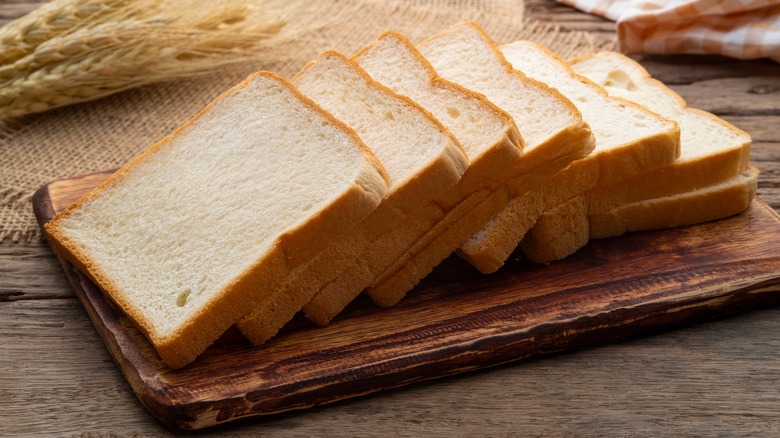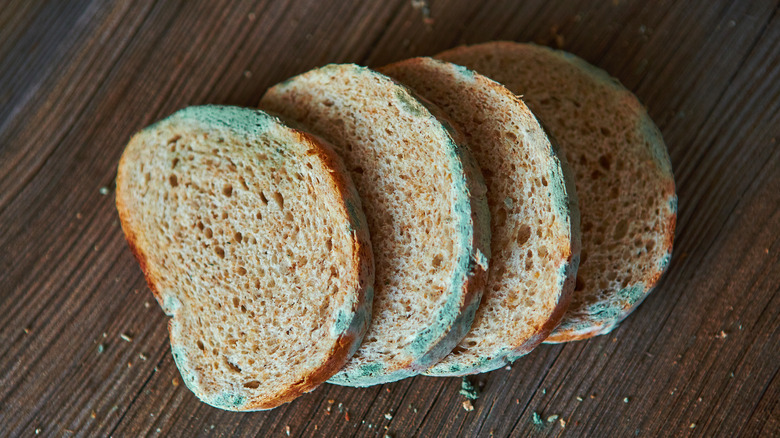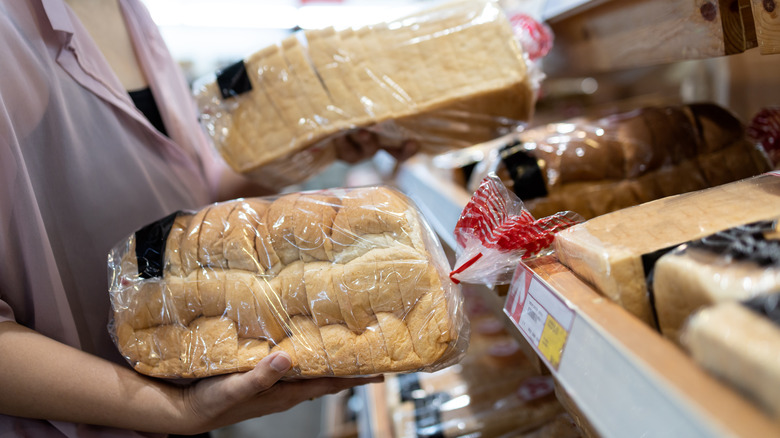The Reason Store-Bought Sandwich Loaves Last So Long
At its heart, bread is one of the simplest foods there is. With such few core ingredients as flour, water, salt, and yeast, it's a testament to human ingenuity that we are able to create so much from so little. At least, that's how it was for most of our history, but if you scan the ingredients list on a loaf of sandwich bread at the grocery store these days, you'll likely see a slew of unrecognizable terms more suited to a chemistry textbook than a cookbook. Preservatives in bread are controversial, but their efficacy can't be denied.
The troublesome thing about bread is how quickly it usually goes stale. It only takes a day or two for a loaf of baguette to turn into a suitable baseball bat. That's not just because the bread is going dry. BBC Science Focus notes that age changes the structure of the starch molecules in bread, which rearrange to form a rigid crystalline structure. You can slow this process a bit if you store your bread in the right place, but the staling process can be frustratingly fast. As our technology advanced throughout the decades, it was only a matter of time before someone decided to address this chemical matter with chemicals.
How food preservatives work
Moldy, stale, and rancid foods have always been a source of frustration for frugal people, and rotting food can lead to a lot of unnecessary waste. Processes like salting, pickling, and canning foods helped to address the problem, but it was during the Industrial Revolution that the use of chemical additives came to prominence. The Science Museum in London reveals that many of the earliest preservatives were later found to be highly toxic, such as the red lead used to color Gloucester cheese. Fortunately, governments began regulating additives in the 20th century, per The Science Museum, but a glance at the ingredients in a loaf of sandwich bread will show you that they still allow a great many chemical preservatives in our food, to varying effects.
The Independent explains that the most prominent group of preservatives in commercial bread is added enzymes. Manufacturers use enzymes on bread to make the dough hold more gas, thereby becoming lighter, and to make bread stay soft for the longest possible time. Another critical group of preservatives is antimicrobials, which prevent mold from growing on the bread. According to Bakers Journal, some antimicrobials are derived from natural extracts, but they can also be synthetic.
Common bread preservatives
You'll have an easy time identifying enzymes in ingredient lists because their names typically end with the suffix '-ase.' BC Campus notes that the main enzymes used in bread making are diastase (amylase) and protease, both of which are naturally present in flour, but may be added to during the manufacturing process. Diastase helps the dough expand and aids in browning the crust, per BC Campus. Commercial bakeries test the diastase content of their flour, and if it is deemed insufficient, they may add more amylase, or another type of flour. Protease, on the other hand, softens the gluten, making the dough more elastic. It is derived from flour, yeast, and malt. Yeast is also the source of additional enzymes, notably zymase, which converts sugars into carbon dioxide gas, causing the dough to rise.
The antimicrobials in bread are more varied than enzymes and are often synthetic. Healthline does note that lactic acid bacteria is a naturally-derived option for producing anti-mold acids. Still, bakers also use chemicals like calcium propionate, sodium benzoate, potassium sorbate, and sorbic acid to protect their products from mold. Per Bakers Journal, propionates are considered the most natural among these, as they occur in certain fruits, grains, and cheeses. If you're wary of chemical additives, it's best to avoid those pillowy loaves of sandwich bread. You can make your own bread or buy from a local bakery that's transparent about its ingredients.


